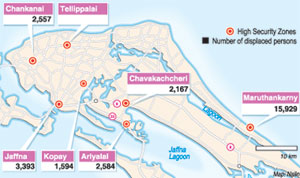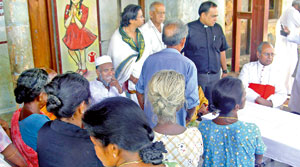| Subramaniam Paramanathan, 76, a former Assistant Secretary of the District Development Council, Jaffna has been an Internally Displaced Person (IDP) for over 20 years living in refugee camps, with friends and relatives and as a tenant.
His house and a 50 perch land in Kondankalatti, Thellipalai, Jaffna had been brought under a High Security Zone (HSZ) forcing him to leave his home during the conflict in the north.
In November last year for the first time he was able to re-visit his land. He found his house razed to the ground, valuable trees felled and the area over-grown.
 |
 |
| Religious leaders from the South who visited Jaffna this week met displaced people from Valigamam North at the abandoned Kondavil railway station. These displaced people were living in this station for the past 20 years. |
“I am too old now to enjoy the benefits of my land. I do not have money or the ability to clear the land and rebuild my house. My only son is in the States and is not interested in returning,” Mr Paramanathan told the Sunday Times.
Mr. Paramanathan was able to visit his land after the government declared parts of the High Security Zones as areas that people could return to. About 35,000 displaced people are still waiting for the government to release those demarcated lands for resettlement.
Mr. Paramananthan and his 11-year-old son fled their home when the fighting escalated. “We had to live on weekly rations provided by the government. I had difficulties in educating my son. Since we found it difficult to live in the camps we moved to a rented house,” he said.
“Finally we moved to a house in Kokuvil paying a monthly rent of Rs. 3,000. With the end of the war the house rents have shot up. This is because people are returning to Jaffna,” he said. “I feel the government does not have a proper plan to help those returning to their lands. They offer Rs. 5,000 to each family to restart life, forgetting that most of the houses have been razed to the ground and the lands grown wild,” Mr Paramanathan said. Many people who were forced to leave their homes during the conflict left behind fertile agricultural land which was also their source of income, he added.
Shanmugalingam Sajeewan, 32 a law student from Thelippallai fled his home at the age of l1 and like thousands of others lived in a camp for the displaced. “We had a two acre land where vegetables were grown. After we fled my father , a lawyer lost his practice as the courts were closed,” Sajeewan said.
“We had to depend on the rations provided by non governmental organizations. Many people in the camp suffered from trauma as they had gone through a lot,” he said.Commenting on the present situation, he said, although the government had granted permission for some of the displaced people to return to their original lands, hardly any facilities have been provided .
“Drinking water facilities are minimal and there are no proper roads. Most of the people are farmers or fishermen, but they have no facilities to carryon with their livelihoods,”he said.
Twenty months after the conflict ended some 89.000 people have been resettled in the north including those displaced from the HSZ.
“We have problems getting people to return to some of the areas as the mine clearing process is still in progress. Apart from the army there are only two foreign organizations helping in clearing the mines,” Jaffna Government Agent Imelda Sukumar told the Sunday Times.
“The process is slow. We are trying to do our best with the available resources including finances. There are no foreign donors coming to help in the resettlement programme. The Indian housing project will begin in July. Some of these houses will be coming up in the former HSZs,” she said.
She said that of the 35,359 persons yet to be resettled in the former HSZs a majority are from the Marudankerny AGA division (15,929 persons). The others are from Jaffna (3,393 persons), Chavakachcheri (2,167), Ariyalai (2,584), Chankanai (2,557) and Kopay (1,589).
Jaffna Security Forces Commander Major General Mahinda Hathurusinghe said they were in the process of gradually allowing people to return to their original homes. “The clearing of mines is underway. The former HSZ area is heavily mined, therefore the clearing up process is slow,” he said.
Major Gen Hathurusinghe said there were only 333 families to be resettled in the former HSZ. |



